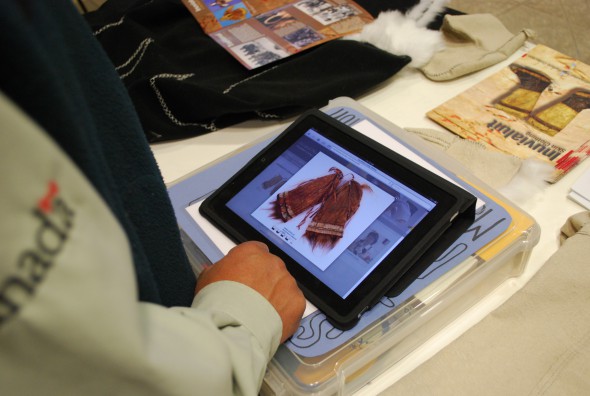Digital Anthropology, Montréal 2011

Community consultation on the Inuvialuit Living History website with Mervin Joe in Inuvik, June 2011.
In November I presented a paper at the Meetings of the American Anthropological Association in Montréal, QC. Our session was entitled “Digital Anthropology: Projects and Projections”, and was organized by Mike Fortun and Kim Fortun of the Rensselaer Polytechnic Institute. This was an exciting session to be a part of, and included: Jason Jackson (Indiana), Kimberly Christen (Washington State), Alison Kenner (RPI), Mike Wesch (Kansas State), Daniel Lende (South Florida), Mark Turin (Cambridge and Yale), Kim Fortun (RPI), Carrie Heitman (Virginia), Alex Golub (Hawaii), and Giovanni Da Col (Cambridge).
Daniel Lende at the University of South Florida posted a great summary of our session and its contributions at Neuroanthropology.
My paper described some of the insights generated through the participatory production of a virtual museum exhibit called Inuvialuit Pitquisiit Inuuniarutait: Inuvialuit Living History, which is a partnership between the Inuvialuit Cultural Resource Centre in Inuvik, the National Museum of Natural History’s Arctic Studies Center at the Smithsonian, Parks Canada, and a team of producers and cultural experts (led by Natasha Lyons, with Catherine Cockney, Charles Arnold, Mervin Joe, Albert Elias, James Pokiak, and Stephen Loring).
My paper abstract:
Cultural Production in the Virtual Museum: From the MacFarlane Collection to Inuvialuit Living History
Digitization is providing heritage institutions with a range of possibilities for sharing curatorial and ethnographic authority with originating communities. More than creating access to collections, institutional practices of making digital collections public have opened spaces for the production of alternative representations of tangible and intangible cultural knowledge. In 2009, a delegation of Inuvialuit elders, youth, cultural workers, and media producers traveled with anthropologists to the Smithsonian Institution’s National Museum of Natural History to view and document the MacFarlane Collection, the most significant collection of Inuvialuit material culture. In the months after the visit, the group worked with Smithsonian curators and developers of the Reciprocal Research Network (http://www.rrnpilot.org) to make the MacFarlane Collection’s digital records available for the Inuvialuit production of a virtual exhibit. “Inuvialuit Living History” remediates publicly available institutional data to demonstrate ongoing connections between the MacFarlane Collection and contemporary Inuvialuit knowledge and cultural practice. In the process, new questions are raised about histories of ownership, the possibility of repatriation, and opportunities and challenges associated with the virtual repatriation of cultural heritage.
